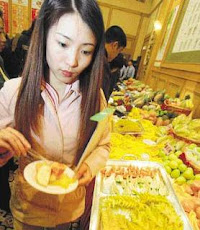Food Trail By SAM CHEONG
JALAN Raja Bot is a place that is close to our reporter's heart. Having spent nearly two decades around the neighbourhood, revisiting this place has invoked plenty of nostalgia.
For starters, this area is connected to Jalan Tuanku Abdul Rahman and with its proximity to Jalan Chow Kit it's often mistaken for 'pasar Chow Kit', considered notorious due to gang fights in the early 70s.

Traditional: Nasi Campur Berulam is one of the specialities at the Bot Market.
And when it comes to food, the Raja Bot area has a colourful reputation. In short, you will never starve because choices are aplenty covering dishes from all races. Naturalised traders of Indonesian descent have taken over many of the business outlets here as the older Chinese residents are slowly fading away.
The first thing you would notice at the Jalan Raja Bot junction, is the covered street bazaars offering food, textile and ornamental products imported from Indonesia and China.
Our reporter recommends two makan places here that had gained popularity with the regulars here. First, if you are a noodle lover and beef is your game -- there's 'Pak Ngah' bihun sup Utara.
Now, this trader made his name back in the mid-80s with his trademarked yellow-coloured turmeric-dyed rice noodles. What's good; is the sambal sauce that goes well with the rich and aromatic beef broth.
And please do not be squeamish when you see the stall owner's assistant adding cold water into the boiling soup where pieces of cow's lung and entrails could be seen floating.

Old hand: Uncle Soo dishing out his wet char koay teow.
If fear is no factor, ask for the bihun sup Utara campur dan tambah inti (soup noodles with additional cow 'spare parts') and at RM3.80 a bowl, the price is unbeatable.
To get the low-down our reporter caught up with Amir “Ghurka” Hamzah (he is often mistaken for a Nepali) who was busy slurping his bowl of hot soup noodles.
The 47-year-old retired Army personnel said he has been a regular at Pak Ngah's stall since the day he started. “Eh, you want good makan here, very simple. Just follow your nose,” said Amir in broken English.
Besides giving a detailed and rich history of the stalls at Raja Bot, the ex-soldier who now works as a factory hand said working-class people prefer to have their food around the area because of the cheap and good factor.
If you take a slow walk around this part of the city, you come across many food stalls that are densely packed, and the choices are aplenty. Most of the traders here are Malays and Indonesians.
From nasi campur to bakso and soto, Amir said people are comfortable with the choices.

Food for everyone: The pedestrian mall in Jalan Raja Bot is a favourite haunt for city dwellers.
Moving on, there is an older part of Raja Bot that few people are aware of . If you want Chinese food, there's the Jalan Haji Hussein covered hawker centre.
This old school makan place was at its height in the late 80s where good hawker fare like curry laksa, nasi lemak, yee yuen fun and char koay teow could be found.
Today, few remaining traders are in their twilight years trying to come to terms with the rapid modernisation. One particular noodle seller whom our reporter had become good friends with is Uncle Soo who owns a 'wet' char koay teow stall at the hawker centre.

Still popular: The Raja Bot market is one of the earliest wet markets in Kuala Lumpur.
Soo has been in business for more than three decades and armed with his trusty wok ladle, he put two of his sons through their tertiary education.
Coming back to his speciality, the man who is in his late 60s said he kept prices for his noodles at a standard rate of RM3 for a small helping and RM3.80 for the larger portion.
What is unique about the man's char koay teow -- is the ingredients. Instead of using 'koo chai', chinese sausage and shrimps, Soo fries his noodles with choy sum, taugeh, fresh blood cockles and eggs. This is a dish that's slowly fading with time. In the past, the central Peninsular had their own style of frying rice noodles and egg noodles. Many of such traders have either died or retired from the business.
Soo, who was a former taxi-driver picked up the art from his 'sifu' who ran the same stall at Jalan Haji Hussein in the late 60s.
“The man taught me everything he knew. I took over in the early 80s and have been maintaining it ever since. My customers are mainly Malays and some regulars who have supported me from day one,” he explained.
He said there is no such thing as retirement as running the char koay teow is the only means to keep him going. The modest trader offered his noodle dish at RM3. Our reporter found the small plate to be filling and nothing much as changed in terms of flavour, just the the lard and pork rind that made it rather tasty was missing.
Other noteworthy stalls at the hawker centre includes a curry noodle seller known as “Kehleng Mui Laksa Fun” (Indian girl curry laksa) that has a loyal following and the wantan mee stall located just a few metres away from Soo's char koay teow.
To get to Jalan Raja Bot, take the Monorail and get off at the Chow Kit station. The Malay warungs are located near the Jalan Tuanku Abdul Rahman bus stop while Jalan Haji Hussein's hawker centre can be found in the ground floor of the City Hall Kuala Lumpur's administrative building in the neighbourhood.




No comments:
Post a Comment